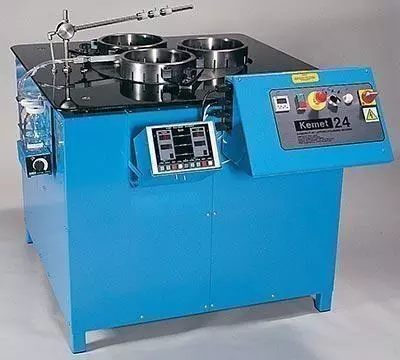What is a Lapping Machine and how does it work
A lapping machine is a specialised machine used for generating very fine surface finishes on a workpiece. It is used in a variety of industries, including aerospace, automotive, and medical, where precise surface finishes are required.
A lapping machine works by using a fine abrasive material in a slurry form to create a fine scratch pattern on the surface of the workpiece. The workpiece is mounted on a rotating spindle and is brought into contact with a flat surface plate, which is also rotated. The abrasive slurry is applied to the surface plate, and the workpiece is rotated against it, creating a fine scratch pattern on its surface. This process is repeated with finer abrasive materials until the desired surface finish is achieved.
Lapping machines are typically used with work holders, allowing multiple workpieces to be processed simultaneously. The speed of rotation, pressure, and abrasive slurry concentration can all be controlled and adjusted to achieve the desired results. The resulting surface finish is highly accurate and consistent, with surface roughness values of just a few microns.
Many types of lapping machines have been developed depending on the parts/components being processed. In lapping, abrasives not only remove the surface roughness of the workpieces but additionally abrade the lapping plate at the same time, which requires the surface of the lapping plate to be always kept accurately flat. In common lapping machines, relative movements of the lapping plate and workpieces are induced from respective rotations and reciprocal movements.
Does Lapping with sandpaper work?
An affordable method of lapping at home for the hobbyist is to use abrasive papers supported on a smooth surface such as plate glass or a flat aluminium plate with diamond or conventional slurry. Wet / Dry sandpaper has been convenient for putting a very fine shiny finish on metal workpieces. This method of using sandpaper won’t give you anywhere near the same results that a lapping plate or lapping machine would.
What is a Micron
A micron is a unit of measurement used to express the thickness or distance between two points. In surface finishing, a micron is often used to describe the surface roughness of a material, with smaller values indicating a smoother surface and larger values indicating a rougher surface. One micron is equal to one-millionth of a meter, or approximately 0.000039 inches.
Lapping vs Grinding
Lapping and grinding are similar finishing processes used to achieve a flat surface on a workpiece. There are some key differences between them:
- Process: Lapping is a mechanical process that uses a fine abrasive material, for example, aluminium oxide, in a slurry form to create a fine scratch pattern on the surface of the workpiece. Grinding, on the other hand, uses a coarse abrasive material, such as a grinding wheel, to remove material from the surface of the workpiece in order to create a flat surface.
- Surface Finish: Lapping results in a much finer surface finish than grinding, with a typical surface roughness of just a few microns. Grinding, on the other hand, typically results in a surface roughness of around 16 microns or more.
- Equipment: Lapping is typically performed using a specialized lapping machine, whereas grinding is performed using a grinding machine.
- Cost: Lapping is a slower process than grinding and is therefore typically more expensive.
- In summary, lapping is used for achieving very fine surface finishes, whereas grinding is used for removing larger amounts of material from the surface of a workpiece and achieving a relatively coarse surface finish.
Lapping vs Polishing
Polishing is a process where fine abrasive particles generate small fractures on the surface of the part, while removing these materials little by little (Known as plastic deformation), this produces a smooth mirror surface. For such polishing, fine abrasives and polishing pads of synthetic material are used to produce smooth mirror finishing. Fine abrasive particles are retained on the pad surface, and the work surfaces are scratched microscopically. Polishing actions are much smaller compared with lapping.

